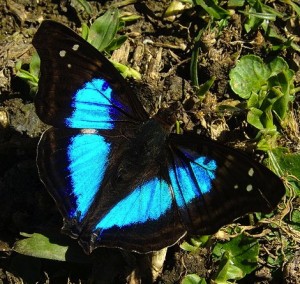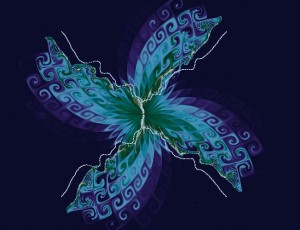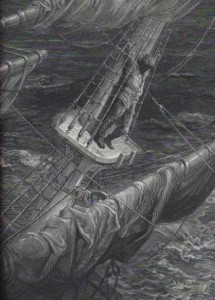A beautiful intersection of art, science and abstract thinking. An assemblage of photos compressed into a circular graph by Fernanda Viégas and Martin Wattenberg.
Tag: Art
Boredom in a fractal world

A few of my students have been complaining that we don’t do enough different things from week to week for them to write a different newsletter article every Friday. PE, after all, is still PE, especially if we’re playing the same game this week as we did during the last.
So I’ve been thinking of ways to disabuse them of the notion that anything can be boring or uninteresting in this wonderful, remarkable world. A world of fractal symmetry, where a variegated leaf, a deciduous tree and a continental river system all look the same from slightly different points of view. A counterintuitive world where the smallest change, a handshake at the end of a game, or a butterfly flapping its wings can fundamentally change the nature of the simplest and the most complex systems.
“Chaos is found in greatest abundance wherever order is being sought. It always defeats order, because it is better organized.”
— Terry Pratchett (Interesting Times)

There are two things I want to try, and I may do them in tandem. The first is to give special writing assignments where students have to describe a set of increasingly simple objects, with increasingly longer minimum word limits. I have not had to impose minimum word limits for writing assignments because peer sharing and peer review have established good standards on their own. Describing a tree, a coin, a 2×4, a racquetball in a few hundred words would be an exercise in observation and figurative language.
To do good writing and observation it often helps to have good mentor texts. We’re doing poetry this cycle and students are presenting their poems to the class during our morning community meetings. It had been my intention to make this an ongoing thing, so I think I’ll continue it, but for the next phase of presentations, have them chose descriptive poems like Wordsworth’s “Yew Trees“*.

The world is too interesting a place to let boredom get between you and it.
Amnesty’s letter writing videos
I showed my class two YouTube videos from Amnesty International that promote their letter writing campaigns. The videos use spare black and white imagery and signatures, written in the air, are used by victims of human rights abuses to escape their persecutors. The video above did provoke a few giggles, because, I suspect, the character animation has a bit of humor to it despite the seriousness of the issues being portrayed. The video below is more powerful. It more frankly addresses the fact that human rights violations are taking place and some of its subjects are children (e.g. child soldiers).
Not all of the students understood at first that the signatures were meant to be their own, and the purpose of the video was to encourage the viewer to write, but they cleared that up after a short discussion. I hope the videos have some long term effect, because pretty promptly after the brief discussion they tried to convince me that I should show the YouTube video of the “Evolution of Dance“.
Evolution and/of dance
My students know my weaknesses too well. I had a well crafted argument today that I should let them watch Judson Laipply‘s YouTube video, “Evolution of Dance“. The gist of the argument was that they never really understood evolution until they saw the video (we covered evolution last year); the way the dance moves evolved, with small changes from one to the other is an excellent analogy for the gradual evolution of organisms. The best example was how The Robot changed into Breakdancing. I let them watch it of course, it was a good argument and the video is pretty harmless. And if it actually helped them learn about evolution ….
“Imagine” “War”
One of the small group assignments last week was to pick two anti-war songs and present their meaning and context. They had a choice of music ranging in time from Frederick Weatherly’s “Danny Boy” to Green Day’s “Holiday”, but they chose two Vietnam Era songs, “Imagine” and “War”.
These turned out to be inspired choices. Not the least because both had music videos that closely reflected the songs’ different approaches to conveying the same message. Lennon’s “Imagine” is peaceful, aspirational, but somewhat subversive, while Edwin Star’s “War” is militant with its rejection of conflict.
The lyrics also provided an excellent contrast in the poetic use of language to convey meaning. After showing the two music videos, the students took the songs apart, stanza by stanza, and you can read the stridency in the punctuation and use of capitals in the lyrics of “War”:
WAR! good God y’all huh
What is it good for?
Absolutely nothing…say it say it SAY IT!
WAR!…uh huh yeah huh!
What is it good for?
Absolutely nothing…listen to me
We had a great discussion. I found this to be an excellent assignment that merged the poetry we’ve been studying in Language Arts with the history and peace education of Social World.
John Lennon – Imagine
Uploaded by hushhush112. – See the latest featured music videos.
A reason to draw
MILTON GLASER DRAWS & LECTURES from C. Coy on Vimeo.
Why do we use our hands? Milton Glaser (above) uses his to think, and he cites Frank Wilson who argues that the hand and the brain are so connected as to be a single almost indistinguishable system. In fact, Wilson extrapolates this connection to education where, he makes the arguement, “less rigid more individualized approach to education will yield a student with a unified body and mind” (according to The New Yorker, 1998).
“The hand speaks to the brain as surely as the brain speaks to the hand” – Robertson Davies in The Cornish Trilogy
Drawing is thinking for some people at least. Perhaps that’s one of the things that defines kinesthetic learners? It certainly is something to bear in mind when designing and implementing the curriculum. Teachers tend to use teaching methods that fit their learning styles, so it is important to bear in mind we will have a variety of students. It’s certainly something about which I have to keep reminding.
It is also important to remember that all students benefit from experiences with different modes of learning. Students, especially adolescents whose brains are rapidly developing new neural pathways and pruning others, need to experience variety, because once we are set in our ways, it becomes a lot harder to learn new tricks.
This is where preparing the environment becomes so important. We want student to have choices, but we want them to try new things, and sometimes these two objectives conflict. The video above does make a persuasive argument to me about why we should draw and practice drawing. Perhaps it will do the same for our kids.
Element song (by Tom Leher)
Tom Leher has a number of really entertaining science related songs. Here he does the elements and someone (unknown unfortunately) has made a video to go with it, where the elements all pop up on the periodic table as he sings. Since there is no apparent pattern to order in which he sings the elements, this is more a “strike the imagination” type thing rather than anything else.
The difference between poetry and prose
Words exist that can, when used by a poet, achieve a dim monochrome of the body’s love, but beyond that they fail miserably. – John Wyndham, The Crysalids

Going into poetry next cycle I’m having some mixed feelings. I like reading poetry, I love hearing poetry, especially when it has something to say. But I can’t write it worth a lick. I have a lot more practice writing prose, and, well, you can judge how well I can do that.
I’ve always wanted to be able to write poetry. I’ve always liked the John Wyndham quote cited above. Poetry can be expressive in a way that prose can’t. Yet prose can tell a story in ways that poetry cannot. There is, of course, a long history of story poems. The Rhyme of the Ancient Mariner was a constant companion when I was bicycling solo around Lake Superior.
At any rate, Brian Beglin has a wonderful review of a novel written by a poet (Margo Berdeshevsky) (found via the Daily Dish). Belgin writes that often the combination does not quite mesh, and in working through why not he comes to the conclusion that poetic phrase do not work in prose because:
When poets write fiction, it can sometimes read like a transfer student trying to navigate the unfamiliar hallways of a new school. Sometimes this works to brilliant effect, as the poet can put a fresh shine on the fiction writer’s familiar tools. In Simon Van Booy’s The Secret Lives of People in Love, the sentences feel brisk, bright, exact, like blocks of ice chiseled into smooth, brimming faces. Conversely, Berdeshevsky’s sentences seem to ache for line breaks, for the leaps and turns vital to a poem but often detrimental to fiction: “There’s a noise she is not waiting for. Scratching like—a light knocking—and again a scratching, as of unsheathed nails on her door.” Craft-wise, these bursts of language are fascinating; yet they have the net effect of poetry: they stop time with their beauty. They can bring a story—which relies on forward momentum, on cause and effect—to a halt.
Not having read the books he references I can’t opine on if he’s right or wrong, however, it is a beautiful distinction he makes: poetic sentences stop time with their beauty, but you don’t want to stop anything when you’re telling a story.
